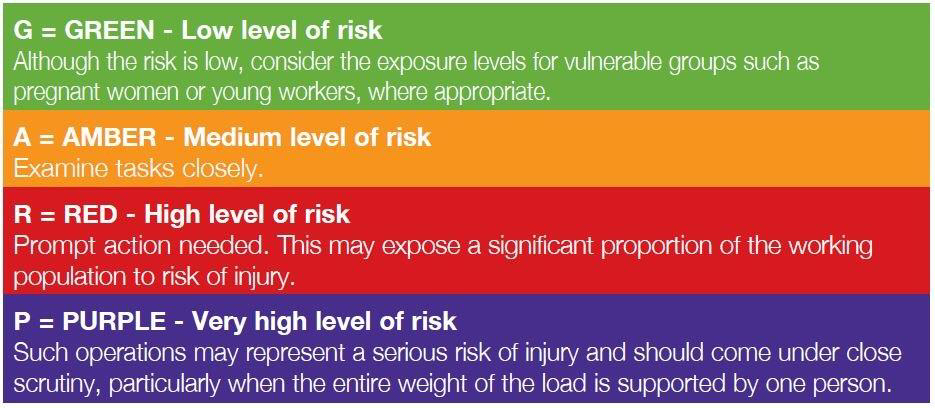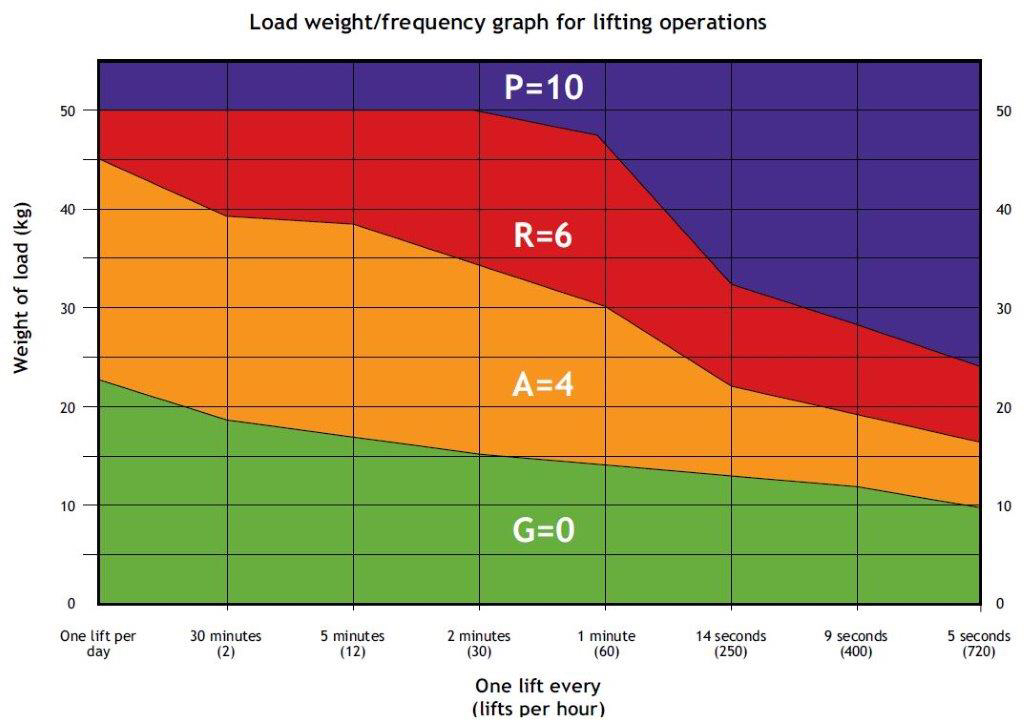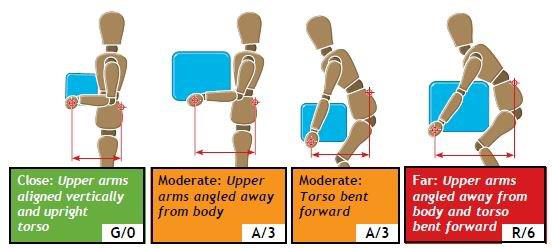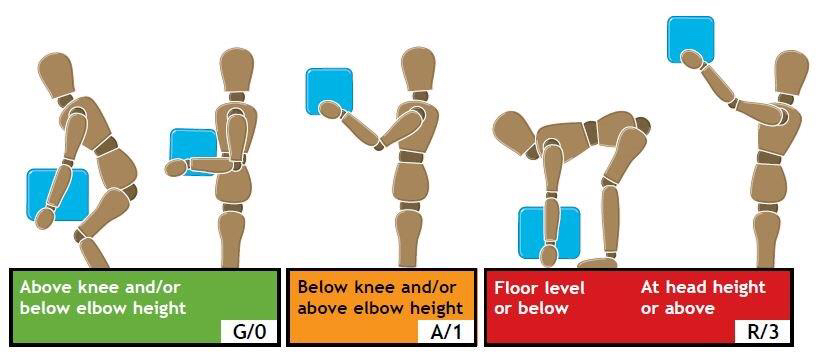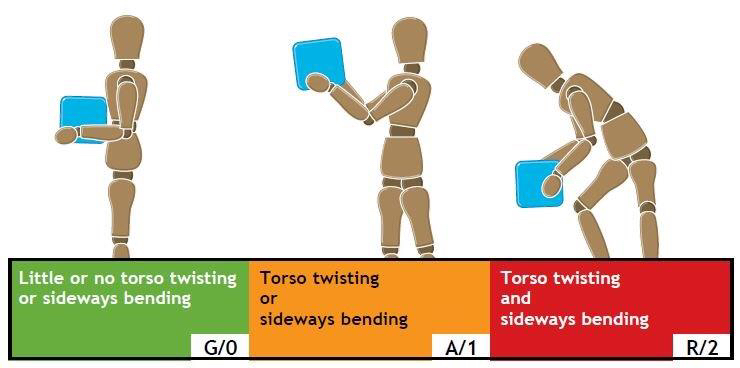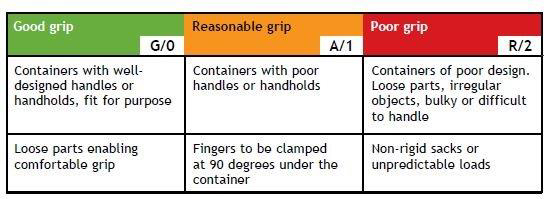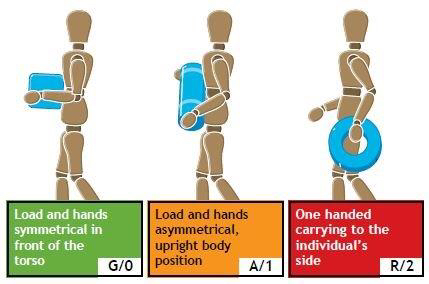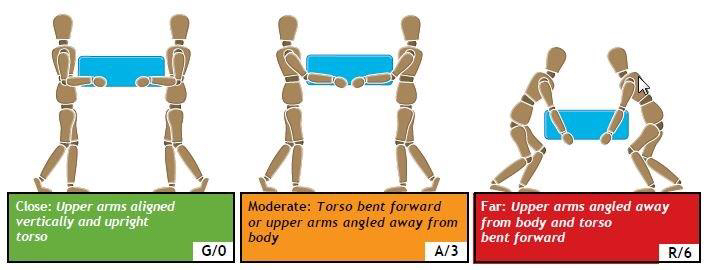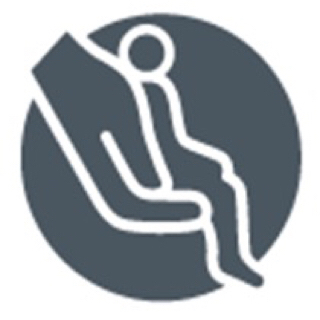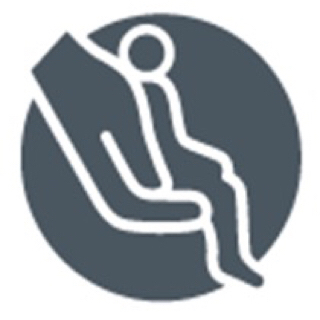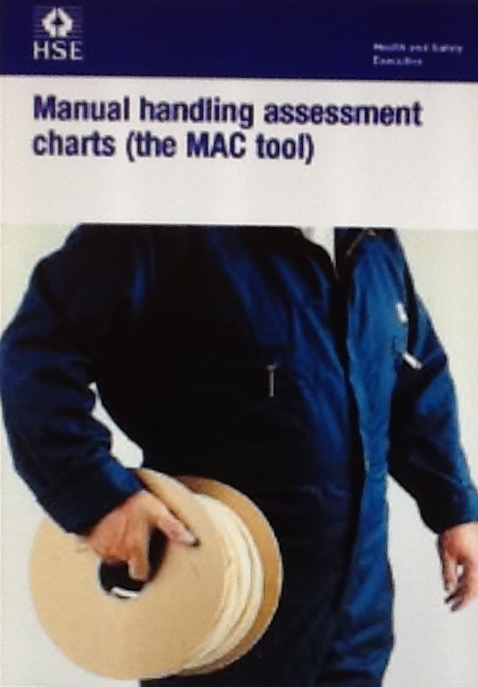Title Page
-
Assessment ref:
-
Task assessed
-
Zone/department
-
Conducted on
-
Conducted by
-
Risk levels:
-
Guidance:
1. Spend some time observing the task (videoing may help) to ensure that what you are seeing is representative of normal working procedures. You should involve your employees and safety representatives during the assessment process. Where several people do the same task, make sure you have some insight into the demands of the job from all employees’ perspective.
2. Select the appropriate type of assessment (ie lifting, carrying or team handling). If a task involves lifting and carrying, consider both.
3. Follow the appropriate assessment guide and flow chart to determine the level of risk for each risk factor. Information on risk reduction can be found on the HSE website at www.hse.gov.uk/msd and in the HSE publication Manual handling at work (see ‘Further reading’).
4. Enter the colour band and corresponding numerical score on the ‘MAC: Score sheet’. The colour bands help determine which elements of the task require attention.
5. Enter the remaining task information and use the scores to help identify which risk factors need to be examined and the total level of exposure to risk.
6. If the individual does a number of tasks, assess each one separately and prioritise action to address the highest scoring task.
7. The total score for each section will be displayed in the report or in the section header - score of zero for each section is ideal.
8. Complete relevant sections
9. Add follow up actions for red areas
Further guidance on using the MAC tool can be accessed online at www.hse.gov.uk/msd/mac.
Employee/task
Employee factors
-
Does the job require above average strength?
-
Is the job a hazard to those that are pregnant?
-
Does the task require special training?
-
Is PPE required?
Task specifics
-
Describe the task and add photographs as necessary
-
Photographs
-
Is the task performed sitting?
-
Constant standing can cause fatigue, sitting and moving loads can also cause difficulty
Assessor name/signature
-
Name/signature
-
Add media
-
Identify whether task is safe or at risk
Lifting operations
A Load weight/frequency:
-
Note the weight of the load and the repetition rate of the lifting operation. Take note of the risk banding from the graph below and enter the colour band and numerical score.
If the colour band is purple, the task should be examined very closely, as such operations may represent a serious risk of injury and should come under close scrutiny, particularly when the entire weight of the load is supported by one person.
Note: High frequency handling operations of light weights will fall within the green zone, but may be associated with upper limb problems. Please refer to Upper limb disorders in the workplace and Assessment of Repetitive Tasks of the upper limbs (the ART tool) (see ‘Further reading’) for advice on further assessment. -
Load weight/frequency
-
Enter score for load weight frequency
B Hand distance from the lower back
-
Observe the task and examine the horizontal distance between the operative’s hands and their lower back. Always assess the ‘worst case scenario’. Use the following image to guide your assessment:
-
Enter score for hand distance to lower back
C Vertical lift region
-
Observe the position of the operative’s hands at the start of the lift and as the lift progresses. Always assess the ‘worst case scenario’. Use the following illustrations as a guide:
-
Enter score for vertical lift region
D Torso twisting and sideways bending
-
Observe the operative’s torso as the load is lifted. If the torso twists in relation to the hips and thighs or the operative leans to one side as the load is lifted, the colour band is amber and the numerical score is 1. If the torso both twists and bends to the side as the load is lifted the colour band is red and the numerical score is 2.
-
Enter score for torso twisting and sideways bending
E postural constraints
-
If the movements of the operative are unhindered, the colour band is green and the numerical score is 0.
If the operative adopts restricted postures during the lift because of the space available (eg a narrow gap between pallet load and hopper) or the workstation design (eg an excessively high monorail conveyor), the colour band is amber and the numerical score is 1.
If the posture is severely restricted, the colour band is red and the numerical score is 3 (eg work in confined areas such as baggage holds). -
Enter score for postural constraints
F Grip on the load
-
Select the score based on the image
-
Enter the score for grip on the load
G Floor surface
-
Select the score based on the image
-
Enter the score for floor surface
H Other environmental factors
-
Observe the work environment and score if the lifting operation takes place: in extremes of temperature; with strong air movements; or in extreme lighting conditions (too dark or bright). If one of the risk factors is present score 1, if two or more of the risk factors are present score 2.
-
Enter the score for other environmental conditions
Additional risk indicators
-
Select additional risk indicators
- Task has history of manual handling incidents
- Task is known to be hard work or high risk
- Employees doing the work show signs that they are finding it hard work (breathing heavily, red faces, sweating)
- Other indications (specify)
-
Specify additional risk factors
Carrying operations
A Load weight/frequency:
-
Note the weight of the load and the repetition rate of the lifting operation. Take note of the risk banding from the graph below and enter the colour band and numerical score.
If the colour band is purple, the task should be examined very closely, as such operations may represent a serious risk of injury and should come under close scrutiny, particularly when the entire weight of the load is supported by one person. -
Load weight/frequency
-
Enter score for load weight frequency
B Hand distance from the lower back
-
Observe the task and examine the horizontal distance between the operative’s hands and their lower back. Always assess the ‘worst case scenario’. Use the following image to guide your assessment:
-
Enter score for hand distance to lower back
C Asymmetrical Torso/Load
-
The operative’s posture and the stability of the load are risk factors associated with musculoskeletal injury. The following illustrations should guide your assessment.
-
Enter score for asymmetrical torso/load
D postural constraints
-
If the movements of the operative are unhindered, the colour band is green and the numerical score is 0.
If the operative adopts restricted postures during the lift because of the space available (eg a narrow gap between pallet load and hopper) or the workstation design (eg an excessively high monorail conveyor), the colour band is amber and the numerical score is 1.
If the posture is severely restricted, the colour band is red and the numerical score is 3 (eg work in confined areas such as baggage holds). -
Enter score for postural constraints
E Grip on the load
-
Select the score based on the image
-
Enter the score for grip on the load
F Floor surface
-
Select the score based on the image
-
Enter the score for floor surface
G Other environmental factors
-
Observe the work environment and score if the lifting operation takes place: in extremes of temperature; with strong air movements; or in extreme lighting conditions (too dark or bright). If one of the risk factors is present score 1, if two or more of the risk factors are present score 2.
-
Enter the score for other environmental conditions
H Carry distance
-
Observe the task and estimate the total distance that the load is carried (not the distance ‘as the crow flies’).
-
Enter the score for carry distance
I Obstacles en route
-
Observe the route. If the operator has to carry a load up a steep slope, up steps, through closed doors or around tripping hazards, the colour band is amber and the numerical score is 2.
If the task involves carrying the load up ladders, enter ‘R’ (red) for the colour band and 3 for the numerical score.
If the task involves more than one of the risk factors (eg a steep slope and then up ladders) total the scores on the score sheet. Enter the ladder height data and/or the angle in the task description box on the score sheet. -
Enter the score for obstacles en route
Additional risk indicators
-
Select additional risk indicators
- Task has history of manual handling incidents
- Task is known to be hard work or high risk
- Employees doing the work show signs that they are finding it hard work (breathing heavily, red faces, sweating)
- Other indications (specify)
-
Specify additional risk factors
Team handling operations
A Load Weight
-
Note the weight of the load and the number of operatives performing the task. Enter the colour band and numerical score below
If the colour band is purple the task should be examined very closely.
Such operations may represent a serious risk of injury and should come under close scrutiny, particularly when the entire weight of the load is supported by the team. -
Enter score for load weight
B Hand distance from the lower back
-
Observe the task and examine the horizontal distance between each operative’s hands and their lower back.
Always assess the ‘worst case scenario’. Use the following illustrations to guide your assessment: -
Enter score for hand distance from lower back
C Vertical lift region
-
Observe the position of the operatives’ hands at the start of the lift and as the lift progresses. Always assess the ‘worst case scenario’. Use the following illustrations as a guide:
-
Enter score for vertical lift reason
D Torso twisting and sideways bending
-
Observe the operatives' torsos as the load is lifted. If the torso twists in relation to the hips and thighs or the operatives lean to one side as the load is lifted, the colour band is amber and the numerical score is 1. If the torso both twists and bends to the side as the load is lifted the colour band is red and the numerical score is 2.
-
Enter score for torso twisting and sideways bending
E Postural constraints
-
If the movements of the operatives are unhindered, the colour band is green and the numerical score is 0.
If the operatives adopt restricted postures during the lift because of the space available (eg narrow space between team members) or the workstation design (e.g. And excessively high monorail conveyer) the colour band is amber and the numerical score is 1.
If the posture is severely restricted, the colour band is red and the numerical score is 3 (eg work in confined areas such as baggage holds). -
Enter score for postural constraints
F Grip on load
-
Select the score based on the image
-
Enter the score for grip on the load
G Floor surface
-
Select the score based on the image
-
Enter the score for floor surface
H Other environmental factors
-
Observe the work environment and score if the lifting operation takes place: in extremes of temperature; with strong air movements; or in extreme lighting conditions (too dark or bright). If one of the risk factors is present score 1, if two or more of the risk factors are present score 2.
-
Enter the score for other environmental conditions
I Communication, co-ordination and control
-
Communication between the operatives is essential when lifting as part of a team. Examples of good communication would be that you may hear the operatives counting ‘one, two, three’ etc before the lift.
Look to see if the team have control of the load, that it is lifted smoothly, and that all members lift together. An unco-ordinated team lift may leave one member of the team bearing the entire weight. -
Enter the score for Communication, co-ordination and control
Additional risk indicators
-
Select additional risk indicators
- Task has history of manual handling incidents
- Task is known to be hard work or high risk
- Employees doing the work show signs that they are finding it hard work (breathing heavily, red faces, sweating)
- Other indications (specify)
-
Specify additional risk factors






